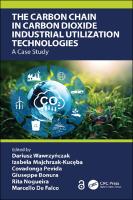The Carbon Chain in Carbon Dioxide Industrial Utilization Technologies
Proposal review
A Case Study
Contributor(s)
Wawrzyńczak, Dariusz (editor)
Majchrzak-Kucęba, Izabela (editor)
Pevida, Covadonga (editor)
Bonura, Giuseppe (editor)
Nogueira, Rita (editor)
De Falco, Marcello (editor)
Language
EnglishAbstract
A shift towards implementation of renewable energy has disadvantages, such as power availability, storage capacity, and accompanying costs, and therefore the potential of clean fossil fuel technologies to ensure the stability of electricity generation needs to be reconsidered until these challenges will be overcome. These clean technologies can help prevent the greenhouse effect and, at the same time, guarantee energy security, as coal is a widespread, price-stable raw material that is available in large quantities. This book focuses on the carbon chain, starting from the formation of CO2, through its capture, possible cleaning, to the production of useful products such as dimethylether, methanol, and carbonated cement prefabricates. The comprehensive case study presents the research results of an international team established within the "CCS-CCU technology for carbon footprint reduction using bio-adsorbents" (BIOCO2) project.
Keywords
Bio-adsorbents;CO2 capture;CO2 purification;carbon capture;emission standards;Fixed-beds reactors;Fluidized-bed reactors;flue gas purification;Hydrothermal carbonization;Pyrolysis;recycled cement;Slurry reactorsDOI
10.1201/9781003336587ISBN
9781032373546, 9781003336587, 9781032373553, 9781000821710Publisher
Taylor & FrancisPublisher website
https://taylorandfrancis.com/Publication date and place
2023Imprint
CRC PressClassification
Conservation of the environment
Environmental science, engineering and technology


 Download
Download Web Shop
Web Shop